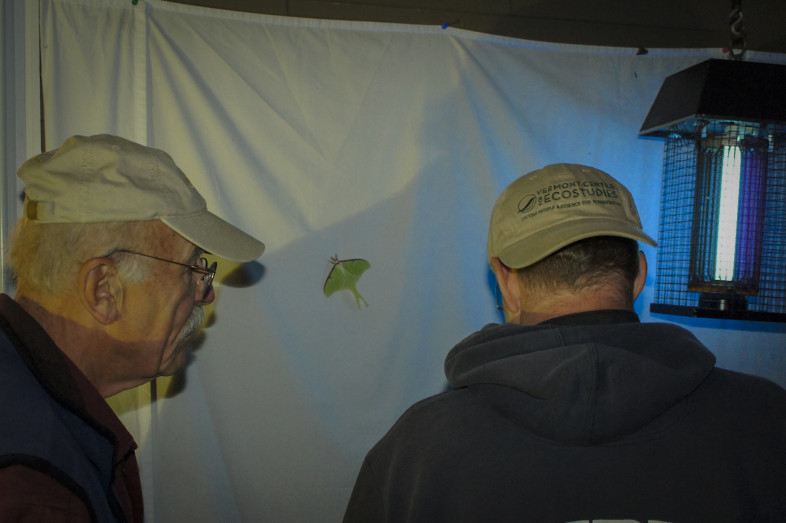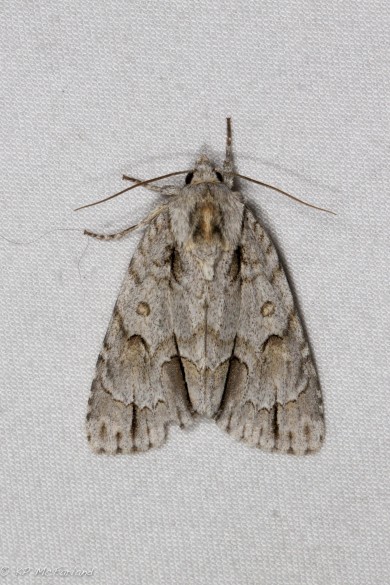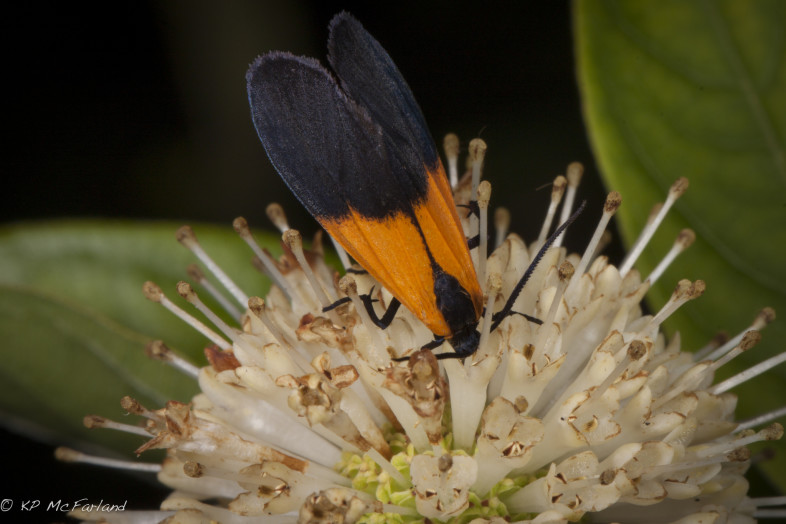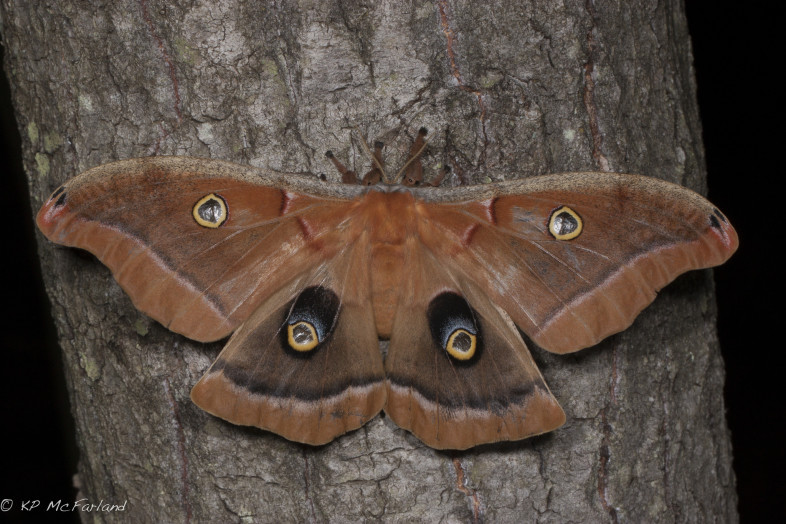
Moth watching on a warm June night. The black light is an old ‘bug zapper’ that has had the zapping parts removed. Bug zappers are not effective at mosquito control, but do needlessly kill moths. With the wires cut to the zapping mechanism, they make great moth watching lights.
The checklist of Vermont moths is being updated by the Vermont Atlas of Life. Thanks to the tireless efforts of both professional and amateur Lepidopterists, since the 1995 landmark publication Moths and Butterflies of Vermont: A Faunal Checklist, nearly 400 new moth species have been found in Vermont. Preliminary results show us that there are now over 2,200 species of moths known from Vermont. And, there are likely many more awaiting our discovery.

Ochre Dagger Moth (Acronicta morula) resting on a sheet with a black light in a backyard.. / © K.P. McFarland
We first began this update by databasing the 1995 Faunal Checklist thanks to the keyboarding effort by JoAnn Russo, a dedicated Vermont moth watcher who is very active on iNaturalist Vermont, a project of the Vermont Atlas of Life. This list is also being updated to current scientific nomenclature. We then began to add new species that have been documented and reported over the last two decades in the Vermont Entomological Society newsletters, personal collections of Michael Sabourin, President of the Vermont Entomological Society and micro-moth expert and others, verified records from various databases, scientific literature, and our project iNaturalist Vermont.
Since 2013, professional biologists and naturalists have contributed moth observations to the Vermont Atlas of Life through our iNaturalist Vermont. Many of us turn on special lights in our backyards on summer nights to find hundreds of moths and other insects gathering on our sheets, hunt fields and forest for day-flying moths, and place rotten fruit bait out to attract other moths. Many of these moths can be identified from good photographs (although some are impossible without dissection and examination under a microscope). With today’s amazing digital photography technology, coupled with the newer Peterson’s Field Guide to Northeastern Moths and web sites like iNaturalist Vermont, BugGuide, Moth Photographers Group, or Moths of Eastern North America Facebook Group, moth watching (aka mothing) has become increasingly popular.
Moth watchers have added a whopping 91 news species to the Vermont checklist via iNaturalist Vermont and have documented 864 species across the state. What’s even more amazing is that we’ve recorded over 15,000 moth observations, which help to understand their phenology, habitat use and range in Vermont like never before.
When we’re finished, Vermont’s moth list will be available for you to query and download. Like all science, this list will keep changing as we learn more and more about Vermont’s moth fauna. At the Vermont Atlas of Life, we’ll be here to keep it up-to-date for conservation, education and appreciation of our natural heritage.
Although many people overlook them, moths are numerous and widespread, with about 12,000 species in North America. They are a major part of our biodiversity and play vital roles in the ecosystem, affecting many other types of wildlife. Both adult and their caterpillars are food for a wide variety of wildlife, including other insects, spiders, frogs, toads, bats and birds. Night-flying adult moths form a major part of the diet of bats. Many of our most beloved songbirds eat both adult moths and their caterpillars, but the caterpillars are especially important for feeding nestlings. Without these moths, the dawn chorus of songbirds would nearly disappear from our forests.
You can help us find new species in Vermont and record and map all moths, rare or common. Take digital photographs and submit your observations to iNaturalist Vermont, a project of the Vermont Atlas of Life. There is much to discover about biodiversity right in our own backyard.

Black-and-yellow Lichen Moth (Lycomorpha pholus) sipping nectar from Buttonbush (Cephalanthus occidentalis). /© K.P. McFarland


Two brothers have written some reflections of growing up in Central Vermont in the 1940s and 50s and mention finding the cocoons of some silk moths. What would be your best guess for the name they are looking for to complete this sentence: “Besides Cecropias, we had some of two related species called Polyphemus and ________.”
They are both still alive and I would like to run your best guess(es) by them.
Thanks so much.
Here’s the giant silkmoths that we have in Vermont:
http://val.vtecostudies.org/projects/vermont-giant-silkmoth-survey/vermont-giant-silkmoth-species/
This morning in Peru, VT I discovered what I think is a Polyphemus moth. Would like to show you. How?
Neat! I love these huge moths. We’d love it if you would share this, and any of your discoveries of biodiversity, on our project called the Vermont Atlas of Life on iNaturalist. Check it out at https://www.inaturalist.org/projects/vermont-atlas-of-life. It is so much fun to use and contribute and there’s even a free smartphone app too! Here are a few resources that also may be helpful:
1. short video tutorials to help get you started (https://www.inaturalist.org/pages/video+tutorials)
2. infographics that quickly show how to get started (https://www.inaturalist.org/pages/getting+started)